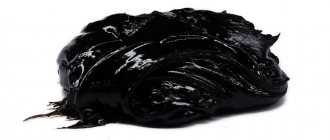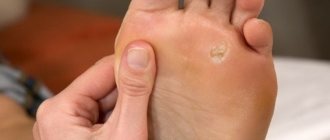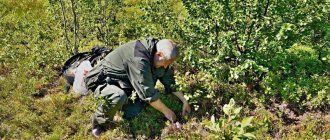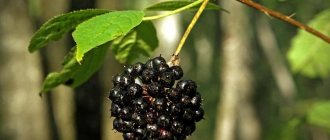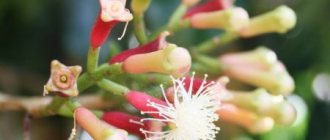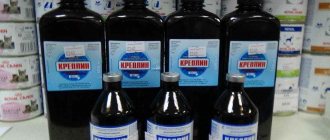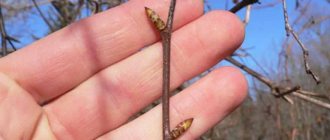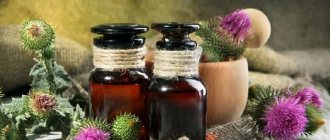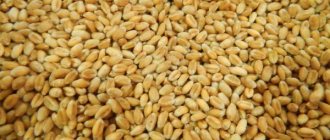Djungarian aconite is a poisonous, perennial, herbaceous plant, which is popularly called king grass, blue buttercup, wolfsroot or skullcap. This plant has a long stem densely covered with leaves and purple flowers that resemble buttercups. The plant can reach 1.8-2 m in height.
Djungarian aconite grows in the wild, where there are high mountain meadows, river banks or wild forests. It can be found in North America, Europe, China, the Himalayas and Nepal. More than 75 species of this herb grow in Russia. Some of them are considered very rare and are listed in the Red Book.
The fruits of the king grass look like dry three-lobed tubers. They are brown-black on the outside and light yellow on the inside. At the top of these elongated processes there are buds. The length of one tuber is 3-8 cm.
Chemical composition of Djungarian aconite
The trunk, flowers, leaves and seeds of this perennial plant contain toxic substances (akonitine alkaloids), but their greatest concentration is in the roots. According to some reports, it can reach 4%. These alkaloids are mesaconitine, icaconitine, hypoaconitine and aconitine. They are insoluble in ordinary water, but dissolve perfectly in chloroform. Tsar grass also contains atizine alkaloids, which are not life-threatening. They are contained in Djungarian aconite in very small quantities, but have a beneficial effect on the heart and cardiovascular system.
In addition to toxic substances, the roots and stems of the described plant contain:
- sugar,
- starch,
- resins,
- daucosterol,
- mesoinosidol,
- saponins,
- coumarin,
- tannins,
- flavonoids,
- coumarin,
- pseudoakonitine,
- vitamin C,
- saponins.
The toxicity of the plant depends, first of all, on the time of collection, its type and the soil in which it grows. Less toxic bushes grow in swampy or flooded areas, and roots collected in spring or early autumn will be more toxic than those collected in winter.
Contraindications for Djungarian aconite:
It is not recommended to treat children with aconite yourself!
Aconite is one of the most poisonous plants in the world. In homeopathy, the pharmaceutical fighter is used in a dilution of 1:1000, 1:1000000 or 1:1000000000000. It must be handled with great care, since the poison, upon contact with the plant, can penetrate even through the skin. The most poisonous part of the plant is the tuber roots, especially in the fall, after the tops have withered. The aerial part is especially poisonous before flowering and during flowering. The degree of toxicity of various aconites is influenced by both the type of plant and the place of distribution, growing conditions, the growing season and the part of the plant being harvested. A.P. Chekhov described cases of poisoning of people on Sakhalin who ate the liver of pigs who were poisoned by aconite tuber roots.
Medicine
The literature describes a case where 3-4 milligrams of aconitine killed an adult. At the beginning of the 20th century, the Dutch doctor Meyer took 50 drops of aconitine nitrate in order to convince the wife of one of his patients that the medicine was not poisonous. An hour and a half later, he showed the first signs of poisoning. Four hours later, a doctor was called to see Dr. Meyer, who found him sitting on the sofa, very pale, with a rapid pulse and constricted pupils. Meyer complained of chest tightness, difficulty swallowing, pain in the mouth and stomach, headache and a feeling of freezing cold. All the measures taken did not help. The feeling of anxiety intensified, the pupils dilated, about forty minutes later attacks of suffocation occurred, and after the third attack (5 hours after taking the medicine), Dr. Meyer died.
European species of aconite are less poisonous. According to some researchers, when European species of aconite are cultivated as an ornamental plant, after 3–4 generations they generally lose their toxic properties. But due to the impossibility of determining at home the quantitative content of alkaloids in a given plant and accordingly assessing the degree of its toxicity, any aconite used must be treated as highly poisonous and strictly follow all the rules for harvesting, drying, storage, preparation of dosage forms and dosage when used . The possibility of poisoning by honey collected by bees from aconite flowers cannot be ruled out. Poisoning occurs most often in cases where the tincture is drunk by mistake or during an attempt to commit suicide. Severe poisoning, including death, is also possible with self-medication. Poisoning with aconite develops quickly, and in severe poisoning, death quickly occurs either from damage to the respiratory center, or immediately from paralysis of the heart muscle.
Lethal doses are about 1 g of plant, 5 ml of tincture, 2 mg of aconitine alkaloid.
Beneficial features
Very small doses of aconitine are used for medicinal purposes , and the therapeutic effect is achieved only after the accumulation of this alkaloid in the human blood. It normalizes breathing and heart rate, inhibits the growth of malignant tumors and prevents the development of infectious diseases.
In order for the body’s forces to activate and begin to fight the disease, this substance must be taken regularly. It gradually accumulates in the body, and then provokes an immune response to fight pathogens.
Djungarian aconite, like Avran officinalis, is used as an antiseptic in the treatment of sexually transmitted diseases, scabies, psoriasis and purulent wounds. Since it contains substances that improve blood flow, tincture of this herb is used for rheumatism, osteochondrosis, radiculitis, fractures and bruises.
In addition, aconite tincture is used in homeopathy to treat:
- headaches, toothaches, migraines,
- gastritis, ulcers, diarrhea, constipation and flatulence,
- hypertension, arrhythmia and angina pectoris,
- Parkinson's disease, paralysis, insomnia, depression,
- schizophrenia, psychosis, melancholy, overexcitation of the nervous system, epilepsy and seizures,
- pneumonia, open form of tuberculosis, pleurisy, bronchitis and tonsillitis.
- infertility, hormonal dysfunctions.
- oncological diseases of various locations,
- as an antidote - for snake bites, poisoning by mushrooms or other poisonous plants.
Where does Djungarian aconite grow?
Djungarian aconite or fighter is a poisonous plant of the buttercup family, quite widespread in the northern hemisphere, in the temperate zone of Eurasia, especially in Siberia.
In Russia alone, there are about 75 species of this plant, each of which is poisonous to one degree or another. Djungarian aconite is considered the king of poisons, but at the same time it is the crown of Tibetan medicine due to its unsurpassed medicinal properties.
Such properties are explained by the presence in the chemical composition of aconite of the strongest alkaloid - aconitine.
In folk medicine, aconite tincture is very popular. Despite certain restrictions and increased caution in its use, aconite tincture remains one of the most effective remedies in herbal medicine for malignant tumors.
If you decide to be treated with aconite, you must make sure that the tincture is made from high-quality raw materials - real Djungarian aconite root.
Growing and harvesting
For the preparation of tinctures and decoctions, the roots of Djungarian aconite are most often used in folk medicine. They are harvested from mid-August to early October.
The dug up tubers need to be cleaned of soil, dirt and washed well in running water. Then the roots of the plant are dried at a temperature of about 60 degrees Celsius. Dry parts of the plant are stored in fabric bags or glass containers for no more than two years. If the harvested raw materials are exposed to sunlight, it will lose all its medicinal properties.
Since this type of grass is poisonous, it must be collected with extreme caution. Always use gloves or mittens, and after finishing work, wash your hands thoroughly and treat them with an antiseptic. After contact with the plant, do not touch your eyes or touch exposed areas of the body.
Preparation of aconite:
Dried tubers of wild plants and their leaves are used as medicinal raw materials. Root tubers are harvested in the fall, from August 15 to October 1. Dig it out with a shovel, clear it of soil and damaged parts, wash it in cold water and quickly dry it at a temperature of 50–70°C, accompanied by good ventilation. From 4 kg of fresh tubers, 1 kg of dry tubers is obtained. The leaves are collected before the plants bloom or during their flowering, withered in the sun and dried under a canopy. The raw material should remain dark green after drying.
Raw aconite must be stored separately from non-poisonous herbs, with the obligatory “Poison!” label, out of the reach of children. Shelf life in bags or closed containers is 2 years.
Since wild and ornamental species of aconite contain poisonous compounds in their stems and tubers, they must be collected after wearing gloves or mittens. While working with aconite, do not touch your eyes, and upon completion of work, wash your hands thoroughly with soap.
Plants should not be placed near beehives to avoid poisonous honey.
You can plant both cultivated and wild species on your site. They all bloom beautifully and for a long time.
Djungarian aconite
In the East, exceptional importance is attached to the place of growth and time of collection of aconite, the method of making the decoction and the administration of the medicine to patients. Aconites growing on the northern slopes of mountains or in mountain depressions are considered the best for medicinal purposes. According to healers, roots collected in early spring (when their sprouts just appear from the ground) or in the second half of summer, after flowering, are more effective. The roots here are dried in bags, hanging them in the shade, since in the sun they lose their toxicity and along with it their healing properties.
Use in folk medicine
Let's look at the most common recipes for preparing tinctures of Djungarian aconite, which are used in homeopathy and folk medicine.
How to take Djungarian aconite for cancer treatment
To prepare the tincture, you need to mix 5-7 g of grated root or dry powder from the tuber with 0.5 liters of alcohol or vodka. The medicine should be stored in a glass jar with a tightly closed lid. Usually it is kept for about two weeks in a dark place, after which it is filtered through a sieve or cheesecloth.
The finished medicine is taken three times a day, one drop, previously diluted in water. Every day the dosage should be increased by one drop, and so to reach 10 drops. Then you need to take this remedy for 10 days, after which you begin to gradually reduce the dosage and again reach one drop per day. After one course of such therapy, a break is taken for 1-5 months, depending on the patient’s personal treatment regimen. A total of 7 courses are required.
Important! If, while taking the drug, the patient feels severe nausea, general malaise and excessive sweating, it is necessary to immediately begin reducing the dosage of the drug by one drop, even if the course has not yet reached its peak. In any case, consult your doctor before starting to take this product.
The effectiveness of Djungarian aconite in the treatment of cancer has been scientifically confirmed. Highly qualified doctors do not deny the practical benefits of this treatment, and in some cases, taking tinctures from this plant is considered as an alternative to chemotherapy.
Treatment of cancer with aconitine tinctures has several advantages over other methods:
- When used correctly, the tincture does not cause side effects or complications, unlike chemotherapy.
- In some cases, the medicine suppresses the growth of tumors and metastases and prevents the spread of new formations.
- The alkaloids contained in the plant help relieve pain in patients, and also neutralizes insomnia and depression.
Feedback from patients after using Djungarian aconite for the treatment of cancer is mostly positive.
Tinctures of aconite for the treatment of headaches, toothaches, pain due to rheumatism
20 grams of powder from the root of Djungarian aconite is poured into 500 ml of vodka and infused for one week. The finished drug takes on the color of tea leaves.
- If you suffer from rheumatism, lubricate the affected area with the resulting product, and then wrap it in a warm cloth.
- For headaches, migraines and neuralgia, the infusion should be consumed one teaspoon every day. The course of treatment is one month.
- This healing tincture can also be used for toothache. To do this, you need to drop the medicine onto the sore tooth or rub it into the gums. The infusion of mountain arnica has the same pronounced therapeutic effect.
The use of Djungarian aconite tincture in the treatment of various pain sensations receives only positive feedback from patients.
Use of aconite jungaris root for paralysis or Parkinson's disease
Mix 2 g of crushed aconite root with 30 g of medicinal blackroot root and 25 g of white peony. Also add 20 g of knotty norichnik and fill the dry mixture with vodka (1 l).
After the mixture has been infused (1 month), it should be consumed every day on an empty stomach. To do this, a drop of tincture must be diluted in 100 ml of water. Every day the dosage should be increased by 1 drop and brought to 35 drops. Then the medicine is taken with a reduction in dosage in the reverse order.
A decoction of Djungarian aconite for treating wounds and boils
Purulent wounds or boils are wiped with an infusion of plant tubers (dry crushed tubers should be dipped in boiling water and boiled for 20 minutes, and then strained). It is also recommended to use aloe juice to treat wounds.
Treatment with aconite
The aconite plant is not recognized by official medicine, but in folk medicine it is used for: arthritis, gout, radiculitis, sciatica, rheumatism, epilepsy, mental and nervous disorders, hysteria, neuralgia, incl. trigeminal neuralgia, for headaches, dizziness, Parkinson's disease, anemia, pulmonary tuberculosis, pneumonia, bronchial asthma, colds, sore throat, acute respiratory disease, blurred vision, worm infection, jaundice, constipation, flatulence, cystitis, dropsy, scarlet fever, diphtheria , malaria, syphilis, psoriasis, scabies. The aconite plant is also used for folk treatment of cancer.
Aconite is used in homeopathy in the form of a tincture of flowers and plant leaves. Due to the increased toxicity of the drug, the dosage is prescribed by a homeopathic doctor after assessing the patient’s condition. In homeopathy, aconite is prescribed for the same indications, as an anti-inflammatory, analgesic, and healing agent.
To treat cancer, you can prepare aconite tincture at home. Take one teaspoon of aconite root powder, pour in 500 ml of vodka and keep for two weeks in a dark room, shaking every day. Before use, carefully strain the tincture using gauze folded in half.
After this, you can begin treatment with aconite: one drop of the product is mixed with 50 ml of water (single dosage) and taken daily before meals three times a day. Every day add 1 drop, bring it up to 10 drops per dose, and so, 10 drops three times a day are taken for another 10 days. After this, the number of drops begins to be reduced and brought back to taking one drop three times a day. After this, treatment with aconite is stopped for one month and then the course is repeated. Thus, seven therapeutic courses are carried out.
To relieve toothache, headaches (including migraines), treat rheumatism, neuralgia, another tincture is prepared: 20 g of Djungarian aconite roots are poured into 0.5 liters of vodka and kept for a week.
For migraines and neuralgia, start taking aconite tincture one teaspoon at a time, gradually increasing the dosage to a tablespoon. Treatment lasts a month.
To eliminate toothache, one tablespoon of tincture should be rubbed into the cheek on the side where the damaged tooth is located.
To treat rheumatism, the tincture is rubbed into the sore spot at night and wrapped in flannel.
Contraindications
Tinctures based on Djungarian aconite are a potent, poisonous remedy. Its purpose must be well thought out, and the expected effect of treatment must exceed the likelihood of side effects. It is not recommended to buy this product on the Internet and use it without consulting your doctor.
- Tinctures are contraindicated for children under 18 years of age.
- Also, the product is not recommended for use by pregnant and breastfeeding women.
- Tinctures made from poisonous alkaloids are contraindicated for people with severe liver diseases and allergies.
Tincture of aconite:
Tincture of aconite: pour 1/2 liter of 45% alcohol or strong vodka, 1 tsp. (without top) finely ground aconite roots (fresh or dry), leave for 14 days in a dark place, shaking daily. Strain through 2 layers of gauze. Take, starting with 1 drop per glass (50 ml) of water 3 times a day 30 minutes before meals. Add 1 drop daily at each appointment and reach 10 drops 3 times a day. Take the tincture at this dosage for 10 days. Then go to reduce the dose, reducing 1 drop daily at each appointment, and reach the original dose - 1 drop 3 times a day. This is a course of treatment.
The break is taken from 1 to 6 months, depending on the treatment regimen prescribed to the patient. During the break, you can continue treatment with other means: hemlock, milestone, fly agaric.
If the patient is treated only with aconite, then take a break for 1 month. Then repeat the course of treatment. A total of 7 courses of treatment are recommended with an interval of 1 month.
Medicinal properties and indications for use of the plant fighter
A decoction of the root of the wrestler is an effective painkiller that is used for headaches and toothaches, rheumatism, sciatica, gout, and neuralgia.
Homeopathic tinctures based on the plant have an anti-inflammatory effect and help reduce fever during colds.
Preparations containing aconite stimulate the cardiovascular system, improve blood circulation, lower blood pressure, and regulate breathing rate.
Alcohol tinctures and ointments based on wrestler are used for the speedy healing of wounds and ulcers, and the treatment of furunculosis.
The plant extract is used in gynecology, as well as for:
- laryngitis;
- pharyngitis;
- measles;
- cystitis;
- scarlet fever;
- hypertension;
- cardiac neurosis;
- angina pectoris;
- arrhythmias;
- tachycardia;
- furunculosis.
In addition, aconite extract is used as part of complex therapy for a number of oncological pathologies. Indications for use of the plant for cancer:
- stomach tumors;
- pulmonary neoplasms;
- skin cancer;
- thyroid tumor;
- neoplasms in the spine;
- prostate cancer;
- cervical cancer.
Reproduction of aconite
Aconite is propagated by seed and bush method.
- In the first case, the young plant may lose the characteristics of the variety, so gardeners are increasingly resorting to the second method. It is recommended to divide the bush every four years. When aconite grows, it loses its external wonder.
- To divide a plant, dig up and separate a part right from the root. Please note that the new part has at least three buds. Place the cut plant in a prepared hole with drainage. On top is a layer of soil. Then mulch and water.
Some plant varieties are propagated by the tuberous method.
Usually, aconites are divided in this way in early autumn.
- Each tuber grows separately until the first buds.
- Then the gardener divides and replants them in soil holes.
- One bud should remain above ground level. Let's deepen the rest.
- Place the holes no closer than thirty centimeters from each other. We mulch and water.
If you want to plant aconite by cuttings, you will need young shoots.
The cuttings are no longer than fifteen centimeters. Plan for the first half of May. Prepare a small greenhouse. This will increase the likelihood of growing a beautiful and healthy flower. As soon as the first green leaves appear, transfer to the ground.
Aconite is propagated by seed in the fall.
- Sow in the ground, where the seeds undergo stratification. This promotes easy germination in the spring.
- The seed is scattered over the holes and covered with a layer of manure to keep warm.
- With the arrival of warmer weather, the earth will warm up faster and newborn aconites will appear.
